A Snapshot of My Conversion
I caught a really bad cold on Jekyll Island so I am going to make this a brief post. After the festivities last night, some of the young LvMI aficionados offered to buy me drinks if I didn’t go back to my room. I considered the offer and texted my wife, “I believe the children are our future…”
Anyway, one of them was an atheist and asked me what made me convert. (I too had called myself a “devout atheist” in undergrad, and now I call myself a born-again Christian.) People ask me this a lot, so let me give the very quick summary of how my beliefs evolved.
(1) I can’t go into the details here, but I went through a very powerful experience in which I experienced firsthand how much one’s beliefs can influence perception. I had always known corny stuff like, “If you want to win the championship, you have to visualize success” or, “The guy who gets the girl is the guy who knows he’s getting the girl.” But I’m talking about much stronger stuff here, like having huge hives on your skin if you’re worried about something.
(2) This newfound knowledge about how much you “create your own reality” made me really understand how it was possible that if a devout Jew truly believed the Messiah had just healed him, that he would actually be healed (of his lameness, leprosy, etc.). Note that at this point I was still an atheist. I just thought that I had figured out the trick. I no longer had to assume there was some guy Jesus who said some neat things, and then his followers invented a bunch of stories to make others pay attention. No, now things made a lot more sense: I thought there had been this guy Jesus who was earnest but had been raised in an unscientific culture, and he really believed he was God. Since he was so confident, he convinced a bunch of other people too. And you can’t blame them; he was literally healing people on the spot. But it wasn’t a miracle or magic; it was all due to the power of the human mind over the physical body, which I had only recently discovered.
(3) At some point (there’s a lot more to the story) it occurred to me that if there were a God and He were to become incarnate as a man etc., that things would appear exactly as my atheistic investigations had revealed. In other words, what more do you want than a guy who goes around healing people, preaching the good news of the kingdom of God, etc.?
I don’t expect the above to persuade anybody who thinks psychomatic medicine is some New Age touchy-feely thing, and that, “If you’re sick you need some good drugs and maybe a CAT scan.” But for whatever it’s worth, it was the path that led from my atheism to theism.
Scott Sumner’s Money Illusions
I believe it was the acerbic von Pepe who said to me over email that Scott Sumner was right–the focus on money was an illusion. (This was a backhanded compliment, to say the least.) I tweaked it a bit for my title…
Lately Scott has been giving us sneak peeks at his book on the Great Depression (e.g. here). Scott’s big thing is that the Fed needs to keep nominal GDP (NGDP) growing in order to stave off calamities. Scott admits there are other “real” shocks that can occur, such as a giant tax hike. But he’s saying that in addition to all that, if the Fed doesn’t print enough money to offset a huge increase in the demand to hold cash (for whatever reason it occurs), then that will be an additional kick to the economy. In particular, Scott thinks it was the Fed’s timidity that caused the Great Depression, as well as the financial crisis of the fall of 2008.
So step 1, I went to the old Austrian workhorse, the depression of 1920-1921. Based on a site that a reader kindly dug up, we learn that the drop in nominal GDP from 1920-1921 was (almost) 17%. That was as big as any single-year drop during the Great Depression, except for the catastrophic year 1931-1932.
So the question is, would anybody say that the economy in 1931 was better than it was in 1921? According to Scott’s theory, you might think that would be the case, since nominal GDP had fallen more sharply from 1920-1921 than from 1929-1930 (down 12%) or from 1930-1931 (down a little more than 16%). Unemployment was 8.7% in 1930, and had risen to 16.3% by 1931. In contrast, unemployment was 11.7% in 1921, but then it dropped down to 6.7% by 1922 and then 2.4% by 1923.
Now in fairness to Scott, he could say it is a cumulative matter, and in fact the figures above support his story. In other words (he could say) the reason unemployment in 1931 was higher than in 1921 (16.3% vs. 11.7%) was that nominal GDP had fallen a cumulative 26% from 1929-1931. So even though the one-year drop in NGDP from 1920-1921 was bigger than any single year drop up through 1931, it was the back to back drops of 1929 and 1930 that broke the back of the economy.
OK in and of itself, that’s plausible enough. But how does Scott explain our current crisis? Assuming my late night calculations from the hotel room are correct, nominal GDP fell about 1.3% from 2008-2009. So how in the heck does that give us a ~10% unemployment rate? (You might ask, “What about the cumulative fall from 2007-2009?” But don’t, because GDP in 2008 was higher than in 2007.)
Now maybe Scott would come back and refine the growth rates, and show that something happened in the 3rd quarter of 2008 that my annual figures above are smoothing out of existence. OK fine, but I don’t think there’s any way Scott is going to generate a recent fall in nominal GDP anywhere close the (almost) 17% one-year drop from 1920-1921. And yet, assuming the stats are measuring the same thing, the unemployment back then was just a point or two higher than it has been in our time.
Now let’s move on to the decisive issue. Over email I asked Scott about these things, and he said (reproducing with permission), “Yes, there was a huge drop in NGDP in 1921, but I don’t see where you are going with this. I agree with the Austrian view that a sharp fall in NGDP is a bad thing, and 1921 certainly supports that, as does 1929-33, when NGDP fell in half. I’m curious to hear your take on it.”
So I said, “OK, I’m saying why did the economy escape a decade of depression in the 1920s–in fact had the Roaring 20s–when in the beginning, the 1920-1921 crash was worse (according to your theory) than the Great Depression crash? Did the Fed start targeting NGDP in 1921?”
Then Scott replied:
Bob, The 1921, 1930 and 1938 depressions were almost equally severe, as my theory predicts. The reason 1929-33 was far worse than 1920-21, is that NGDP fell in half between 1929 and 1933. Even by 1931, NGDP had fallen more steeply than in 1920-21. I think 1920-21 fits my theory perfectly, and make that argument in my book.
And yes, Strong was basically targeting NGDP in the 1920s. He said he was concerned about fluctuations in both prices and real output; that’s essentially NGDP targeting. NGDP grew fairly steadily between 1921-29, which is why the economy did well. When it fell in half after 1929, the economy did poorly. If NGDP had kept falling after 1921, as it did after 1930, the 1921 depression would have been much worse.
The 1921 depression was short, but deeper than our current recession. It ended quickly because NGDP recovered strongly in late 1922.
(Hang on kids, we’re almost to the finish line.) I came back with this gem: “But wait a second, of course if the economy recovers from a depression (whether because of wise Keynesian stimulus, Sumnerian Fed policy, or Austrian chanting) NGDP will recover. But I’m saying, can you point to what the Fed did to cause NGDP to recover in late 1922?”
Scott explained: “The [monetary] Base fell sharply in 1921, and rose sharply in 1922.”
OK for those who are still with me, let me show you how difficult it is to square the numbers on monetary base growth to fit Scott’s narrative from above.
In the chart below, I have taken the St. Louis Fed’s “Adjusted Monetary Base” series, the non-seasonally adjusted one. The data is monthly, which made it hard to see broad trends. So what I first did was construct quarterly averages out of the monthly data.
Then, I constructed 6-month growth rates for each quarter. So for example, the entry for 1920 1Q is 16.3%. What that means is that the average monetary base level in the 1st quarter of 1920 was 7.86% higher than the level in 3Q 1919. Since the base by 1st Q 1920 had grown 7.86% over the past 6 months, that works out to an annualized growth rate of monetary base of 16.3%. OK?
Now that you understand what the growth rates mean, check out this table:

I’ve put the significant money tightening periods in red, and the loosening periods in green. Now pretend for a minute that you knew nothing of the time periods, and you were applying Scott’s theory. You want to predict which periods have the worst recessions.
OK the biggest reduction in monetary base occurs in 1921. It’s true, the drop in 1937 is bad, but clearly the 1921 drop is worse. And the drop in 2008 is…oh wait, there was no drop in base. You just saw a slowdown in its growth.
Now at this point, we would expect the worst depression in US history to be in 1921, the second worst to be in 1937, and the third worst in 1930. We wouldn’t even expect there to be a depression in 2008. (You can’t see it in the excerpts I’ve given you, but there were other periods post-WW2 where monetary base actually fell or grew very anemically, and yet I don’t think [off the top of my head] there were bad recessions in those periods. Clearly not “the worst Depression since WW2” which is what we are currently experiencing.)
OK let’s be fair to Scott. He could argue that we need to look at the Fed’s rescue of the economy in 1922, when (per Scott’s email) monetary base grew rapidly. So we should expect to see the most phenomenal growth in monetary base in 1922, in order to counteract the huge restriction in the base in 1921. Otherwise, it would remain a mystery how the economy bounced back so quickly in 1922.
Uh oh. My measure of base growth was negative through the first half of 1922. And then even when it picked up, the highest it hit was 11.1% in the 4th quarter of 1922. Remember, unemployment had dropped about five percentage points–falling about in half–from 1921 to 1922.
So if the second-half spurt in 1922 explains the dramatic recovery–and indeed paved the way for the Roaring Twenties–then what was the problem in late 1931? The growth in monetary base then was much bigger than in late 1922. And yet we all know that unemployment continued to rise.
A similar puzzle occurs when we look at the huge, and consecutive, growth rates in 1938 and 1939. But unemployment was 19% in 1938, and was still 14.6% in 1940. Scott can give a story about “long and variable lags” to blame the spike in unemployment in 1938 on the monetary contraction in 1937, but how can he explain the post-1921 recovery by monetary base spurts that are pipsqueaks compared to the huge injections frmo 1938-1940?
Up till this point, Scott could maybe get by with a story that involved judicious use of cumulative effects etc. But look now to the green cells in late 2008 and early 2009. !!
I submit that Scott has fallen prey to a money illusion. Of course it can screw things up if our fractional reserve system allows a huge contraction in the money supply when other things are falling apart in the real economy. But just look at the 1920-1921 episode compared to 2008-2009. It is unreasonable to say the basic cause of our current malaise is that the Fed tightened up in 2008 and then didn’t open the spigots enough after the crisis set in. The numbers aren’t even in the right ZIP code for that explanation.
Back to you, Scott.
(NOTE: I am writing this from a hotel room. I reserve the right to change the numbers above in case I googled the wrong unemployment rate for a certain year, or screwed up the division for computing nominal GDP losses.)
Recreating the Crime Scene at Jekyll Island
If the international bankers are smart, they will have added a secret ingredient to the catered lunch on Saturday. A bunch of us rebels are at Jekyll Island, where the blueprints for the Federal Reserve were designed–and they definitely fell into the wrong hands, namely, the hands of the guys who wrote them.
The classic work on all this stuff is The Creature from Jekyll Island: A Second Look at the Federal Reserve. I heard that it was a kook book (not to be confused with a cook book) but I’m about halfway through and I’m waiting to hit the crazy stuff. Of course, it could just be that I’m crazy.
Zbigniew Brzezinski: How Jimmy Carter and I Started the Mujahadeen
If I didn’t know any better, I’d say this was a conspiracy theory involving high-ranking US government officials, so it can’t possibly be right… But anyway check out this amazing 1998 interview of Zbigniew Brzezinski that Brad DeLong dug up:
Interview of Zbigniew Brzezinski, Le Nouvel Observateur (France), Jan 15-21, 1998, p. 76*
Q: The former director of the CIA, Robert Gates, stated in his memoirs [“From the Shadows”], that American intelligence services began to aid the Mujahadeen in Afghanistan 6 months before the Soviet intervention. In this period you were the national security adviser to President Carter. You therefore played a role in this affair. Is that correct?
Brzezinski: Yes. According to the official version of history, CIA aid to the Mujahadeen began during 1980, that is to say, after the Soviet army invaded Afghanistan, 24 Dec 1979. But the reality, secretly guarded until now, is completely otherwise: Indeed, it was July 3, 1979 that President Carter signed the first directive for secret aid to the opponents of the pro-Soviet regime in Kabul. And that very day, I wrote a note to the president in which I explained to him that in my opinion this aid was going to induce a Soviet military intervention.
Q: Despite this risk, you were an advocate of this covert action. But perhaps you yourself desired this Soviet entry into war and looked to provoke it?
Brzezinski: It isn’t quite that. We didn’t push the Russians to intervene, but we knowingly increased the probability that they would.
Q: When the Soviets justified their intervention by asserting that they intended to fight against a secret involvement of the United States in Afghanistan, people didn’t believe them. However, there was a basis of truth. You don’t regret anything today?
Brzezinski: Regret what? That secret operation was an excellent idea. It had the effect of drawing the Russians into the Afghan trap and you want me to regret it? The day that the Soviets officially crossed the border, I wrote to President Carter: We now have the opportunity of giving to the USSR its Vietnam war. Indeed, for almost 10 years, Moscow had to carry on a war unsupportable by the government, a conflict that brought about the demoralization and finally the breakup of the Soviet empire.
Q: And neither do you regret having supported the Islamic [integrisme], having given arms and advice to future terrorists?
Brzezinski: What is most important to the history of the world? The Taliban or the collapse of the Soviet empire? Some stirred-up Moslems or the liberation of Central Europe and the end of the cold war?
Q: Some stirred-up Moslems? But it has been said and repeated: Islamic fundamentalism represents a world menace today.
Brzezinski: Nonsense! It is said that the West had a global policy in regard to Islam. That is stupid. There isn’t a global Islam. Look at Islam in a rational manner and without demagoguery or emotion. It is the leading religion of the world with 1.5 billion followers. But what is there in common among Saudi Arabian fundamentalism, moderate Morocco, Pakistan militarism, Egyptian pro-Western or Central Asian secularism? Nothing more than what unites the Christian countries.
* There are at least two editions of this magazine; with the perhaps sole exception of the Library of Congress, the version sent to the United States is shorter than the French version, and the Brzezinski interview was not included in the shorter version.
I am quite sure that if some “nutjob” posited this theory in 1980, he would be denounced as a paranoid pinko: “Yeah right, as if the US provoked the Soviet Union. Do you believe everything the Russkies tell you? I’m sure. Next you’ll be telling me the Soviets felt threatened with all those nuclear warheads pointed at them. Like the US would ever nuke people. That’s something Iranians would do, not us. We’re the good guys.”
Can I Pass the Keynesian Turing Test?
Robert Barro has a pretty interesting WSJ op ed today, in which he uses his historical analysis of government spending and tax multipliers to evaluate the Obama Administration’s stimulus package of 2009.
In a nutshell, Barro first estimates a spending multiplier of 0.4 (in the first year) and a tax multiplier of -1.1. So if the government spends $100 billion and doesn’t touch taxes (i.e. borrows and spends an extra $100 billion), then GDP goes up by $40 billion. What that means is that there is 60% crowding out. The expenditure of $100 billion directly raises GDP by $100 billion, but then other components of GDP (private consumption, investment) fall by $60 billion. Hence, the net effect on GDP (in the first year) from an additional $100 billion in deficit-financed spending is only $60 $40 billion, according to Barro’s analysis of periods of big spurts in military spending.
On the other hand, Barro finds that if the government raises $100 billion in new taxes (while holding spending constant), this lowers GDP by $110 billion.
So putting the two effects together, Barro estimates the 5-year impact of the stimulus plan. The idea is that the government “buys” some output on the front end (because the spending multiplier is above 0), but then has to forfeit output (relative to the baseline) on the back end because the higher debt requires more taxes. Barro concludes:
We can now put the elements together to form a “five-year plan” from 2009 to 2013. The path of incremental government outlays over the five years in billions of dollars is +300, +300, 0, 0, 0, which adds up to +600. The path for GDP is +120, +180, +60, minus 330, minus 330, adding up to minus 300. GDP falls overall because the famous “balanced-budget multiplier”—the response of GDP when government spending and taxes rise together—is negative. This result accords with the familiar pattern whereby countries with larger public sectors tend to grow slower over the long term.
The projected effect on other parts of GDP (consumer expenditure, private investment, net exports) is minus 180, minus 120, +60, minus 330, minus 330, which adds up to minus 900. Thus, viewed over five years, the fiscal stimulus package is a way to get an extra $600 billion of public spending at the cost of $900 billion in private expenditure. This is a bad deal.
The fiscal stimulus package of 2009 was a mistake. It follows that an additional stimulus package in 2010 would be another mistake.
OK I wanted to test whether I really understand the Keynesian mindset. So I honestly haven’t looked yet to see what DeLong and Krugman have to say about this. Here’s my guess:
My Guesses as to the Keynesian Response to Barro’s Op Ed
(1) Barro is a liar, second only to Russ Roberts in his lyinghood.
(2) Barro’s spending multiplier is way too low. He admits that he derives it from studying wartime periods, but that’s absurd. During such periods, the government enacts strict rationing measures to ensure that private consumption and investment stay suppressed, freeing up resources for the war effort.
(3) Barro’s use of the 2008 baseline is absurd. If the government had sat back and done nothing, unemployment would have continued climbing, perhaps it would have been 15% right now. That would mean lower tax revenues and more spending on social welfare programs. In essence, all the stimulus does is concentrate that unavoidable government debt increase into the beginning years, when it might obviate much of the later spending. Barro has done the equivalent of looking at a patient just diagnosed with cancer, and comparing the medical expenses of early intervention against a “baseline” of a perfectly health person’s medical costs.
(4) Barro’s spending multiplier makes no sense, both in theory and in terms of empirical evidence. In an economy with 10% unemployment and 0% interest rates, running a fiscal deficit doesn’t cause any crowding out. We would see the telltale signs if it did. So right now, when the government spends an extra $100 billion with borrowed money, that doesn’t cause a $60 billion reduction in spending elsewhere. How could it? What is the mechanism? And not only does the $100 billion raise GDP directly by that amount, with no $60 billion offset, but in fact we get further GDP gains because of the further spending by people who would otherwise have been unemployed. Barro casts aspersions on Christina Romer’s estimates of a multiplier greater than 1, but he doesn’t explain what her mistake was. He just says he can’t understand her figures and asserts his own. What pseudoscientific nonsense. Why oh why can’t we get right wing economists who know more than discredited views from the 1930s?
OK kids, go look. I promise this was off the top of my head. How did I do?
Taylor Conant Asks: Do We Live in a Movie?
Here’s the rest of his email:
A bad one? Just saw this ad:
So, here’s the script– a government take-over of a major auto manufacturer, who happens to be dabbling in onboard vehicle “safety” technology that allows the company’s vehicles to be controlled from a central location, and the competition is being brought down by legislative and executive agency inquiries and hearings, and a police force that is increasing militarized and has been indoctrinated to see civilians as game to be hunted and dominated. A psychological thriller exploring the psychosis of the hunters and the fearful desperation of the hunted as they try to escape the fast-enclosing walls of a terrifying police state. oh, and they’re being RFIDed, too.
Submitizen, coming December 2010, tag line “Nowhere to run, nowhere to hide.”
I mean seriously, any idiot should be able to see “Hmm, if the cops can get my stolen vehicle back that easily, I also can be easily detained, say if they suspect me of drunk driving, running drugs, etc. and then proceed to be harassed” but of course, they won’t.
Two Cheers for Credit Cards
(Not three cheers, mind you.) The intro:
Ever since someone in grad school deviously introduced me to the concept of “irrational” debt aversion, I have been carrying credit-card balances that are far too high. Believe me, I understand the tricks these companies pull, like the clause in fine print where you unwittingly pledged away your firstborn.
I have had credit-card employees explain matter-of-factly to me that it was in my interest that they apply payments to the balances with the lowest interest rates first, and I was once driven to vulgarity on the phone by a representative who got philosophical with me when I was trying to close an account with a zero balance.[1] So believe me when I say that I get it when people complain about credit-card companies.
Yet in the present article I want to describe some of the benefits of these seductive tools of a modern financial economy. Although many critics would argue that credit cards show the flaws of capitalism, they also showcase its strengths.
And if you want to see what’s good about credit cards, you’ll have to read the article.
More Disinflation Disinformation
In a recent blog post titled, “More on Disinflation” Paul Krugman comments on the headlines trying to interpret the recent CPI announcement:
As Mark Thoma recently suggested…it’s odd that most macroeconomic forecasts show inflation remaining stable or even rising despite continuing very high unemployment. Both history and logic suggests that this is wrong.
And declining inflation is clear using any core measure. The Fed, I happen to know, tends to focus on the core personal consumption expenditure deflator:
There are some strange bobbles in this measure, suggesting that it’s not as good a measure of inertial inflation as advertised, but leaving that aside we see, once again, serious disinflation as a result of the recession.
I still think there’s a real risk we’ll turn Japanese.
If you want to see me tackle the claim that both theory and history support Krugman’s belief that high unemployment ==> low price inflation, see my recent Washington Times op ed.
Also of relevance is the fact that Krugman focused on an odd time frame. Here’s the full picture:

Now is it really jumping out at you that the Price Index of Personal Consumption Expenditures–stripped of food and energy–go down during recessions?
And even in the periods where it does seem to work, is the mechanism really the Keynesian one about recessions being caused by a fall in aggregate demand? Couldn’t you just as easily explain it by saying that people have to buy food and energy, and so when their prices spike–especially if it’s during tough times–then the prices of everything else tend to fall?
In other words, my point here is that people say, “Oh we’re stripping out volatile food and energy to look at the underlying trend.” But since people care a lot more about food and energy than a lot of the remaining purchases, that’s closer to throwing out the trend and looking at the residual.

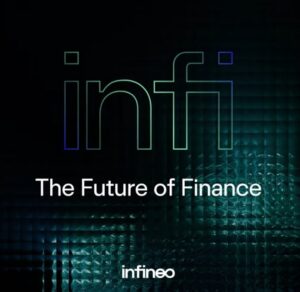
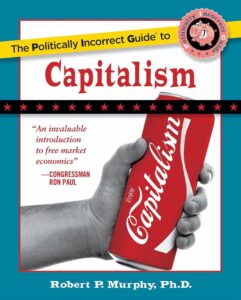
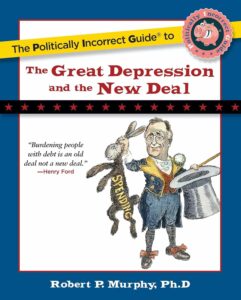
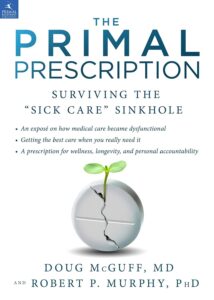

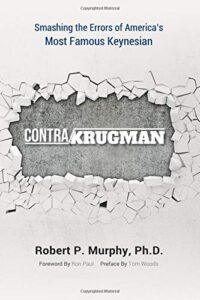
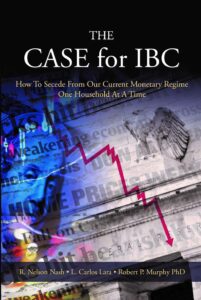
Recent Comments